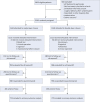Effect of single- versus double-layer uterine closure during caesarean section on postmenstrual spotting (2Close): multicentre, double-blind, randomised controlled superiority trial
- PMID: 32892392
- PMCID: PMC7983985
- DOI: 10.1111/1471-0528.16472
Effect of single- versus double-layer uterine closure during caesarean section on postmenstrual spotting (2Close): multicentre, double-blind, randomised controlled superiority trial
Abstract
Objective: To evaluate whether double-layer uterine closure after a first caesarean section (CS) is superior compared with single-layer uterine closure in terms of postmenstrual spotting and niche development in the uterine caesarean scar.
Design: Multicentre, double-blind, randomised controlled superiority trial.
Setting: Thirty-two hospitals in the Netherlands.
Population: A total of 2292 women aged ≥18 years undergoing a first CS were randomly assigned to each procedure (1:1): 1144 women were assigned to single-layer uterine closure and 1148 women were assigned to double-layer uterine closure.
Methods: Single-layer unlocked closure and double-layer unlocked closure, with the second layer imbricating the first.
Main outcome measures: Number of days with postmenstrual spotting during one menstrual cycle 9 months after CS.
Secondary outcomes: perioperative and menstrual characteristics; transvaginal ultrasound measurements.
Results: A total of 774 (67.7%) women from the single-layer group and 770 (67.1%) women from the double-layer group were evaluable for the primary outcome, as a result of drop-out and amenorrhoea. The mean number of postmenstrual spotting days was 1.33 (bootstrapped 95% CI 1.12-1.54) after single-layer closure and 1.26 (bootstrapped 95% CI 1.07-1.45) after double-layer closure (adjusted mean difference -0.07, 95% CI -0.37 to 0.22, P = 0.810). The operative time was 3.9 minutes longer (95% CI 3.0-4.9 minutes, P < 0.001) and niche prevalence was 4.7% higher (95% CI 0.7-8.7%, P = 0.022) after double-layer closure.
Conclusions: The superiority of double-layer closure compared with single-layer closure in terms of postmenstrual spotting after a first CS was not shown. Long-term obstetric follow-up of our trial is needed to assess whether uterine caesarean closure guidelines should be adapted.
Tweetable abstract: Double-layer uterine closure is not superior for postmenstrual spotting after a first caesarean; single-layer closure performs slightly better on other outcomes.
Keywords: Caesarean section; double layer; niche; postmenstrual spotting; single layer; uterine closure technique.
© 2020 The Authors. BJOG: An International Journal of Obstetrics and Gynaecology published by John Wiley & Sons Ltd.
Figures


Comment in
-
Too close to call: uterine closure technique at caesarean section.BJOG. 2021 Apr;128(5):879. doi: 10.1111/1471-0528.16475. Epub 2020 Oct 2. BJOG. 2021. PMID: 32892469 No abstract available.
References
-
- Boerma T, Ronsmans C, Melesse DY, Barros AJD, Barros FC, Juan L, et al. Global epidemiology of use of and disparities in caesarean sections. Lancet 2018;392:1341–8. - PubMed
-
- Sandall J, Tribe RM, Avery L, Mola G, Visser GH, Homer CS, et al. Short‐term and long‐term effects of caesarean section on the health of women and children. Lancet 2018;392:1349–57. - PubMed
-
- Bij de Vaate AJM, Brölmann HAM, van der Voet LF, van der Slikke JW, Veersema S, Huirne JAF. Ultrasound evaluation of the Cesarean scar: relation between a niche and postmenstrual spotting. Ultrasound Obstetrics & Gynecol 2011;37:93–9. - PubMed
-
- van der Voet LF, Bij de Vaate AM, Veersema S, Brolmann HA, Huirne JA. Long‐term complications of caesarean section. The niche in the scar: a prospective cohort study on niche prevalence and its relation to abnormal uterine bleeding. BJOG 2014;121:236–44. - PubMed
Publication types
MeSH terms
Grants and funding
LinkOut - more resources
Full Text Sources
Medical

